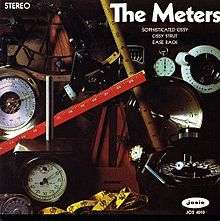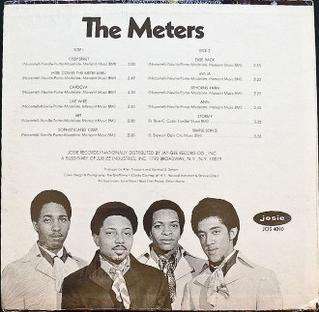The Meters (album)
The Meters is the debut album by the American funk group The Meters. It was released in May 1969, the first of eight albums by the band. The band's early works were developed through improvisation.[1] Band members had spent most of the 1960s performing together in nightclubs of New Orleans. They had a fluid musical style that included elements of R&B, rock, and jazz.[1][2]
| The Meters | ||||
|---|---|---|---|---|
 | ||||
| Studio album by | ||||
| Released | May 1969 | |||
| Recorded | 1969 | |||
| Genre | Funk | |||
| Length | 43:05 | |||
| Label | Josie (JOS-4010) | |||
| Producer | Allen Toussaint, Marshall Sehorn | |||
| The Meters chronology | ||||
| ||||
Background
The first track, "Cissy Strut," was the band's opening song during their residency at the Ivanhoe nightclub in late 1960s. The original melody was introduced by Leo Nocentelli. The song was not yet titled, and the band's name was Art Neville and the Neville Sounds.[3](p2) The song was recorded at the Cosimo Studios.[3](p1) It was first released as a single and sold 200,000 copies in two weeks. Its commercial success became an impetus for the band's name change and subsequent recording career.[3](p2)
The variety of instruments on the album's cover symbolizes the diversity of compositions and rhythms.[4](p199) Its back cover depicts the band members in the early phase of their career. Many of the band's early instrumental tracks were named only after they were recorded. The album's eighth track was named for the 6V6 vacuum tube, which is commonly used in guitar amplifiers.[5][6]
Reception
| Review scores | |
|---|---|
| Source | Rating |
| Allmusic | |
| Revive Music | Positive[8] |
| Vermont Review | Positive[9] |
A review by AllMusic noted the music's simplicity and nuance and called it "impressive".[7] Tamara Davidson of Revive Music had a positive review and wrote "the album is filled with infectious grooves, filthy bass lines, and revolutionary drum rhythms."[8] According to Brian Knight of The Vermont Review, the album "set the pace for both the Meters and the entire New Orleans funk sound."[9]
Jeff Chang described the band in relation to the cultural backdrop of the 1960s, their influences, and their influence on music. He wrote: "Modeliste once described the songs as 'soundbites,' as 'entries of different grooves and different ideas about groove.' Indeed, they could fill a jam-band encyclopedia, hundreds of little ideas that could each be stretched out like twenty-minute rubber bands."[4](p206)
Track listing
All tracks are written by Art Neville, Ziggy Modeliste, Leo Nocentelli and George Porter Jr., except where noted.
| No. | Title | Length |
|---|---|---|
| 1. | "Cissy Strut" | 3:06 |
| 2. | "Here Comes the Meter Man" | 2:55 |
| 3. | "Cardova" | 4:35 |
| 4. | "Live Wire" | 2:40 |
| 5. | "Art" | 2:35 |
| 6. | "Sophisticated Cissy" | 2:56 |
| 7. | "Ease Back" | 3:14 |
| 8. | "6V6 LA" | 2:26 |
| 9. | "Sehorn's Farm1" | 2:31 |
| 10. | "Ann" | 2:46 |
| 11. | "Stormy" (Buddy Buie, J.R. Cobb) | 3:40 |
| 12. | "Simple Song" (Sly Stone) | 3:06 |
| No. | Title | Length |
|---|---|---|
| 13. | "The Look of Love" (Burt Bacharach, Hal David) | 3:39 |
| 14. | "Soul Machine" | 3:28 |
1 Listed as "Sehorns Farm" on original LP release; and "Sehorns Farms" on original 45rpm single.
Personnel
Credits adapted from AllMusic.[10]
- Art Neville – organ, keyboards, composer
- Ziggy Modeliste – drums, composer
- Leo Nocentelli – guitar, composer
- George Porter Jr. – bass guitar, composer
- Production
- Allen Toussaint – producer
- Marshall Sehorn – producer
- Giovanni Scatola – remastering
- Janie Gans – art supervisor
- Jake Kennedy – liner notes
- Composition (track 13) – Burt Bacharach, Hal David
Charts
- Weekly charts
| Chart (1969) | Peak position |
|---|---|
| US R&B Albums (Billboard)[11] | 23 |
| US Billboard 200[11] | 108 |
- Singles
| Title | Year | Peak chart positions | Album | |
|---|---|---|---|---|
| US [11] |
R&B [11] | |||
| "Cissy Strut" | 1969 | 23 | 4 | The Meters |
| "Sophisticated Cissy" | 34 | 7 | ||
| "Ease Back" | 61 | 20 | ||
Further reading
- Jeff Chang (2007). "The Meters". In Phil Freeman (ed.). Marooned: The Next Generation of Desert Island Discs. Da Dapo Press. pp. 195–208. ISBN 9780306816406. Retrieved July 26, 2016.
References
- Dave Thompson (2001). Funk, Third Ear: The Essential Listening Companion. Hal Leonard. pp. 164–169. ISBN 9780879306298. Retrieved November 15, 2015.
- Grace Lichtenstein; Laura Dankner (1993). Musical Gumbo: The Music of New Orleans. W.W. Norton. pp. 153–160. ISBN 9780393034684. Retrieved November 15, 2015.
- Randy Ray (January 25, 2011). "Leo Nocentelli and That Original Spark". jambands.com. Archived from the original on May 4, 2011. Retrieved December 21, 2016. Archive page 2
- Jeff Chang (2007). Phil Freeman (ed.). Marooned: The Next Generation of Desert Island Discs. Da Dapo Press. pp. 195–208. ISBN 9780306816406. Retrieved July 26, 2016.
- Bryan Wawzenek (July 16, 2010). "The Gibson Interview – Leo Nocentelli of The Meters". Gibson.com. Archived from the original on May 15, 2016. Retrieved December 20, 2016.
- 6V6 tube:
- Dave Hunter (August 1, 2009). "5 6V6-Powered, Low-Wattage Tube Combos". guitarplayer.com. Archived from the original on March 11, 2016. Retrieved December 21, 2016.
- Justin Colletti (March 14, 2013). "The Best Small Tube Amps for the Recording Studio". sonicscoop.com. Archived from the original on November 13, 2016. Retrieved December 21, 2016.
- "Allmusic – The Meters album – review". allmusic.com. Archived from the original on April 16, 2015. Retrieved March 10, 2011.
- Tamara Davidson (September 13, 2011). "The Meters, Self-Titled Album". Revive Music. Archived from the original on November 15, 2015. Retrieved November 15, 2015.
- Brian Knight. "Get Dazed by the Meters". The Vermont Review. Archived from the original on November 10, 2004. Retrieved November 15, 2015.
- "Allmusic – The Meters album – credits". allmusic.com. Archived from the original on November 15, 2015. Retrieved November 15, 2015.
- Dave Thompson (2001). Funk, Third Ear: The Essential Listening Companion. Hal Leonard. pp. 167–168. ISBN 9780879306298.
